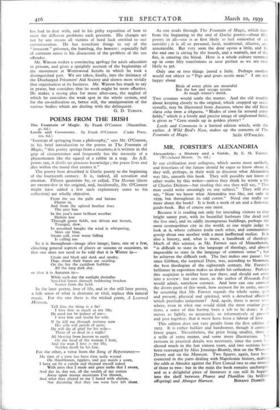MR. FORSTER'S ALEXANDRIA
Alexandria : a History and a Guide. By E. M. Forster. (Whitehead Morris. 7s. 6d.)
IF our civilisation ever collapses, which seems most unlikely, and historians of the future should be eager to know about it, they will, perhaps, in their wish to discover what Alexandria was like, unearth this book. They will possibly not know of other works by this writer—unless they think he wrote a life of Charles Dickens—but reading this one they will say, "This man could write amusingly on any subject." They will also say, "Now we know what Alexandria was like, not only in 1939, but throughout its odd career." Need one really say more about the book? It is both a work of art and a first-rate guide-book. But of course one must.
Because it is reading not only for intending visitors to that bright sunny port, with its beautiful harbours (the dead and the live one), and its oddly incongruous buildings, perhaps the most cosmopolitan city in the world, as one might judge to look at it, where cultures jostle each other, and communities gossip about one another with a most ineffectual malice. It is also a history, and, what is more, a handbook of theology. Much of this science, as Mr. Forster says of Monotheism, "is difficult to state in the language of theology, and almost impossible to state in the language of common sense " ; but he achieves the difficult task. The fact makes one pause: for since Gibbon, the sceptical Deist, was, according to Newman, the best theologian of the eighteenth century, Mr. Forster's brilliance in exposition makes us doubt his orthodoxy. Perhaps this suspicion is neither here nor there, and should not enter into a review : but one must, as the author of Howards End would admit, somehow connect. And how can one connect the divers parts of this work, how account for its unity, except by assuming that Mr. Forster regards the whole scene, pat and present, physical and spiritual, with a detached affection which precludes judgement? And, again, there is never any- where, even in what one would think the most routine por- tions, a sense of this having been a job to be done: it all moves so lightly, so accurately, so informatively of present and past together, that it must have been a labour of love.
This edition does not vary greatly from the first edition of 1922. It is rather bulkier and handsomer, though it contain; fewer pages. Nevertheless, the print being smaller, there is a trifle of extra matter, and some more illustrations. 1'ct revision in practical details was necessary, since the town ha. altered much in the last sixteen years, and two sections ha‘ e been rearranged by Miss Jennings-Bratnly, that on the Western Desert and on the Museum. Two figures, again, have bee corrected in the parts dealing with Napoleonic history, making the odds at Aboukir against the First Consul two to one instead of three to two: but in the main the book remains unchanged. and as a delightful piece of literature it can still fit happflr into the shelf between Pharos and Pharillon (its brilliant










































 Previous page
Previous page